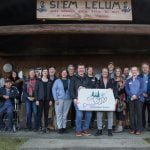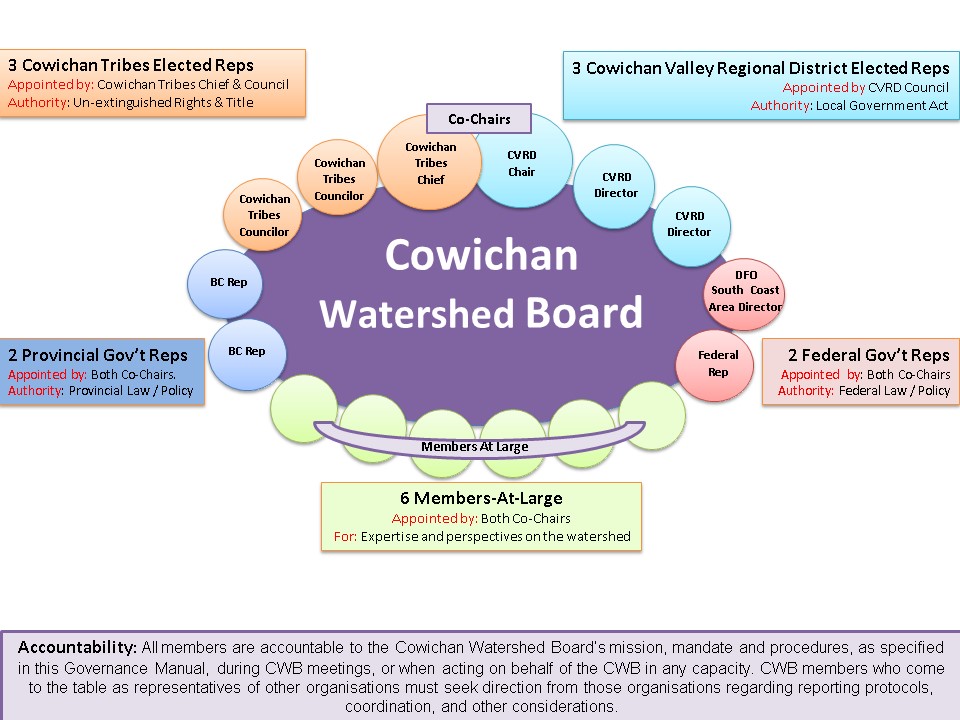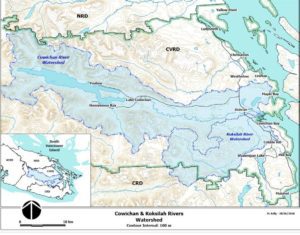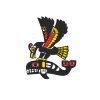Our Watershed Home: From the headwaters of Cowichan Lake to the estuary at Cowichan Bay, and including the large Koksilah sub-basin, the Cowichan is a world-renowned watershed. It is designated as both a federal and provincial Heritage River, and vital to the culture and economy of the entire Cowichan Region. Home to five species of wild salmon and four species of trout, the Cowichan River is treasured for fishing and recreational opportunities. The underlying aquifer provides some of the best drinking water in Canada.
The Cowichan Watershed Board (CWB) is a local governance entity created in 2010 to promote water and watershed sustainability in the Cowichan/Koksilah watersheds, ancestral home of the Quw’utsun First Nation. Co-chaired by Cowichan Tribes and the Cowichan Valley Regional District (CVRD), the Board represents a unique partnership between First Nations and local government. Through this model, Cowichan Tribes and the CVRD work together to advance whole-of-watershed health, demonstrating a commitment to moving down the path of reconciliation. The Board has a strong track record of planning and implementing technical work, creating a culture of water conservation, promoting science-based advocacy and implementing respectful community-based solutions.
See our case study feature in Why BC Needs Watershed Boards by the BC Watershed Security Coalition.
“We do this because it’s the right thing to do. It’s not because we’re mandated by the Province – that’s not what drives reconciliation. It’s local relationships.” (Brian Carruthers, CVRD Chief Administrative Officer)
“You guys are just as important to us as we are to you.” (Chief William Seymour, Chief of Cowichan Tribes First Nation)
 Our Work: As is the case in many watersheds across B.C., the Cowichan-Koksilah watershed faces a number of challenges to water sustainability, including threats to water quality, water supply and cumulative impacts to habitat. The CWB is working to address these challenges, in collaboration with all levels of government and the local stewardship community. The CWB is described as an example of "reconciliation in action." Among other approaches, the CWB and its partners are seeking and take advantage of opportunities associated with the Water Sustainability Act, and working to increase seasonal water storage in Cowichan Lake. The Board also convenes four Working Groups of organizations and governments that work collectively towards 7 aspirational Targets for Watershed Health.
Our Work: As is the case in many watersheds across B.C., the Cowichan-Koksilah watershed faces a number of challenges to water sustainability, including threats to water quality, water supply and cumulative impacts to habitat. The CWB is working to address these challenges, in collaboration with all levels of government and the local stewardship community. The CWB is described as an example of "reconciliation in action." Among other approaches, the CWB and its partners are seeking and take advantage of opportunities associated with the Water Sustainability Act, and working to increase seasonal water storage in Cowichan Lake. The Board also convenes four Working Groups of organizations and governments that work collectively towards 7 aspirational Targets for Watershed Health.
In 2017-2018, the Board undertook a year-long review of its governance structure and opportunities to improve the stewardship and protection of the watershed. Please see the report Pathways and Partnerships: A Framework for Collaboration and Reconciliation in the Cowichan Watershed.
Our Purpose: The purpose of the CWB is to serve as a formal entity to improve collaborative management and decision-making to protect and enhance the health of the whole of the Cowichan and Koksilah watersheds (collectively referred to as the Cowichan Watershed).

Cowichan Watershed Board and partners at "Setting the Course" planning and governance workshop, Jan 2023. Photo B Hetschko
Our Mandate: The CWB’s mandate is to provide leadership for sustainable water management to protect and enhance ecosystem health in the Cowichan Watershed guided by the Cowichan teaching: Muks ‘uw’slhilhukw’tul – We are all inter-connected.
Working in collaboration with Cowichan Tribes, CVRD, and the Provincial and Federal Governments, the Board shall promote wise water management practices throughout the watershed by:
- advocating for the well-being of the watershed;
- guiding and coordinating the implementation of the (Cowichan Basin Water Management) Plan [editor: and subsequent plans];
- providing timely, balanced and thoughtful advice to senior and local government authorities including First Nations;
- securing stable funding sources to support water management activities,
- engaging local stakeholders in water management decisions;
- involvement in data-gathering and monitoring the health of the watershed,
- providing and accessing specialized expertise and knowledge for sustainable water management in the Cowichan watershed; and,
- developing public outreach and extension tools to enhance watershed thinking and to increase residents’ understanding of water science, stewardship and management activities.
The Board recognizes that various levels of government exert authority to make management decisions within the Cowichan Watershed including Cowichan Tribes, CVRD, the Province and the Federal Government. The CWB operates within the context of the interplay of these jurisdictions, as shown in the Organizational Structure Diagram below.

CWB Organizational Structure Diagram (click image to download)
[Excerpted from the Cowichan Watershed Board Governance Manual , September 2018 revision]
For more information, please read Pathways and Partnerships: A Framework for Collaboration and Reconciliation in the Cowichan Watershed, September 2018
See our Home page for key reports and documents about the watersheds and the Watershed Board to learn more.
(Photos this page courtesy of Cowichan Tribes, Parker Jefferson)
_________________
History and Strength of Cowichan Watershed Board (Excerpt from Pathways and Partnerships: A Framework for Collaboration and Reconciliation in the Cowichan Watershed, 2018.)
Stewardship of the Cowichan River is a recognized success story in British Columbia, with a well-documented history of community-based collaboration. The Cowichan Watershed Board traces its roots to a drought crisis in 2003, when extremely low flows in the river prevented Chinook salmon from migrating upstream, and Catalyst Paper faced imminent shutdown.
The response to this crisis was to create a plan for the watershed in 2007: the Cowichan Basin Water Management Plan (CBWMP or the “Plan”). This award-winning Plan includes goals, objectives and actions concerning water conservation, supply management, quality, habitat and biodiversity, governance, and communications.
A plan, however, does not go far without an ability to implement it. The CWB was explicitly formed in 2010 to fulfill this critical implementation role... From the Plan, the CWB also drafted a set of its own “plain language” aspirational targets to give focus and inspiration to the work.
In 2016, the CWB passed a motion to include the Koksilah sub-basin in its geographic mandate, even though it was originally excluded from the Plan.
Early on in the CWB’s evolution, it was recognized that the distant and/or compartmentalized governance bodies that made decisions for the watershed were part of the problem. Calls for “local control” resonated throughout the watershed, giving voice to the widely held belief that the people who live in an area know it best and benefit most from good management, and therefore should have more involvement in and responsibility for watershed decisions.
From its creation, the Board has been a co-governed entity based on partnership between Cowichan Tribes and the CVRD. The inaugural co-chairs were Lydia Hwitsum, Chief of Cowichan Tribes and Gerry Giles, Chair of the CVRD, with Rodger Hunter, a coastal and wetland biologist and senior manager in the BC Government, hired as Coordinator. Other elected representatives from the partners also serve as Board members, along with community representatives appointed by the co-chairs or senior levels of government. The Board is also supported by a strong Technical Advisory Committee [Working Groups] that provides both local knowledge and scientific expertise.
For almost a decade, the CWB has been active in the watershed, building a range of programs and growing into a unique and leading example of local watershed governance in B.C. The Board has successfully built capacity through partnership, embracing a wide array of supporters and community-based collaborators.




 Email
Email



